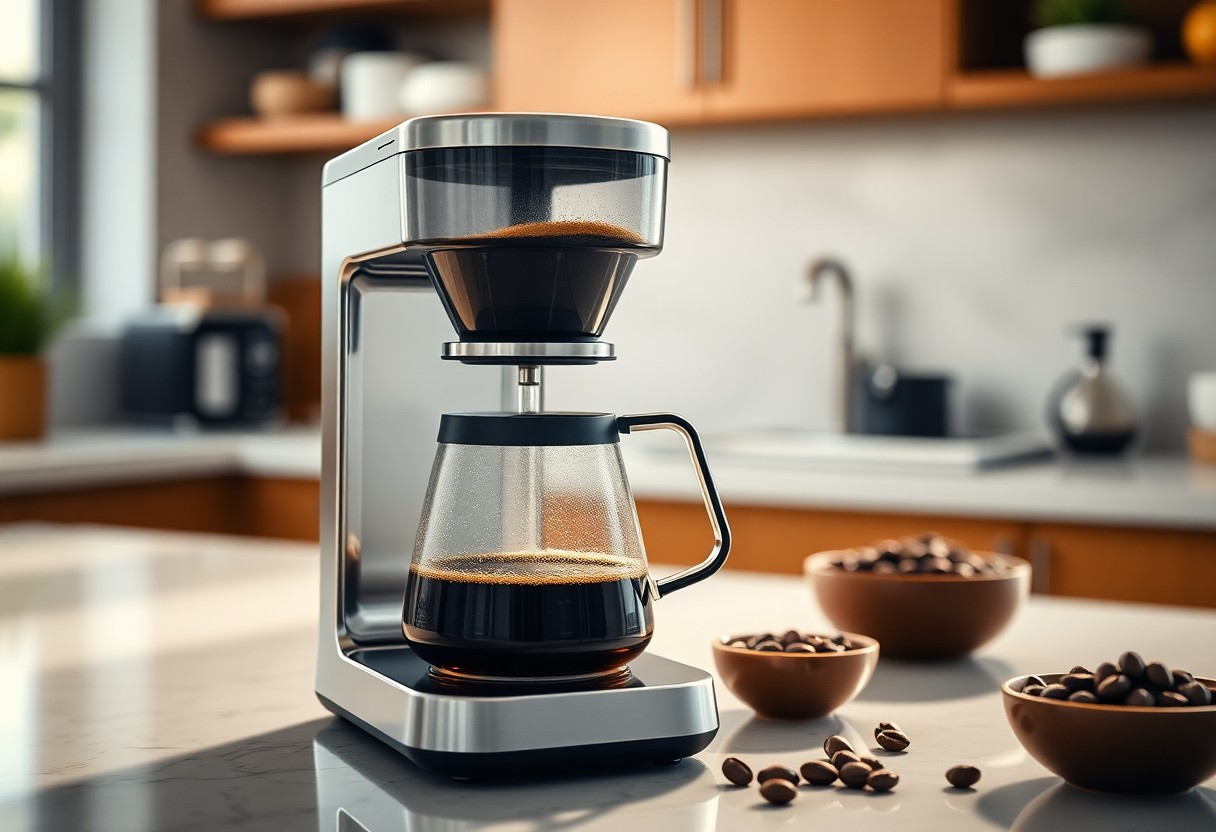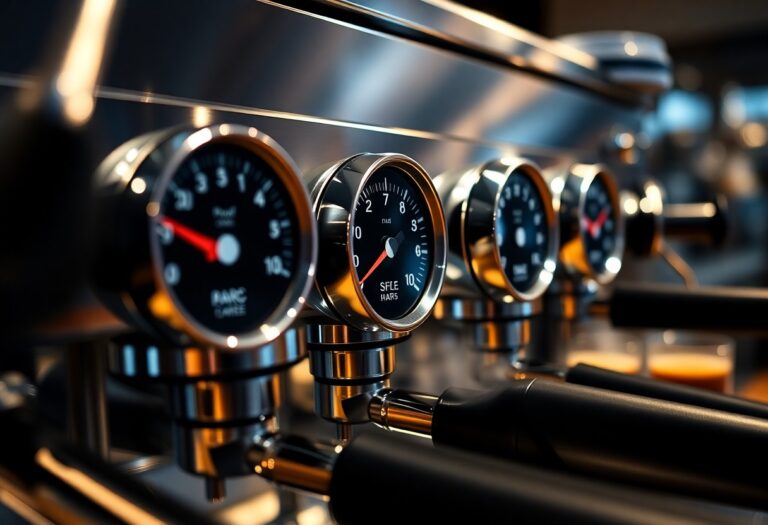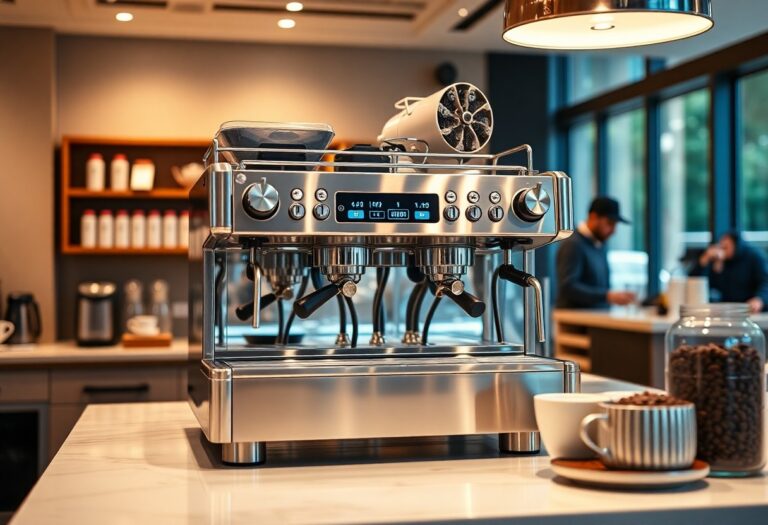What is a Filter Coffee Machine – Drip Brewing System
Many coffee lovers turn to a filter coffee machine, also known as a drip brewing system, for a consistent and rich cup of coffee. With this machine, you can easily brew multiple cups at once, making it perfect for mornings when time is short. This system works by gradually dripping hot water over ground coffee, allowing for optimal extraction of flavors while avoiding bitterness. However, it is important to maintain and clean your machine regularly to prevent any buildup of residues, which can negatively affect the taste of your brew.
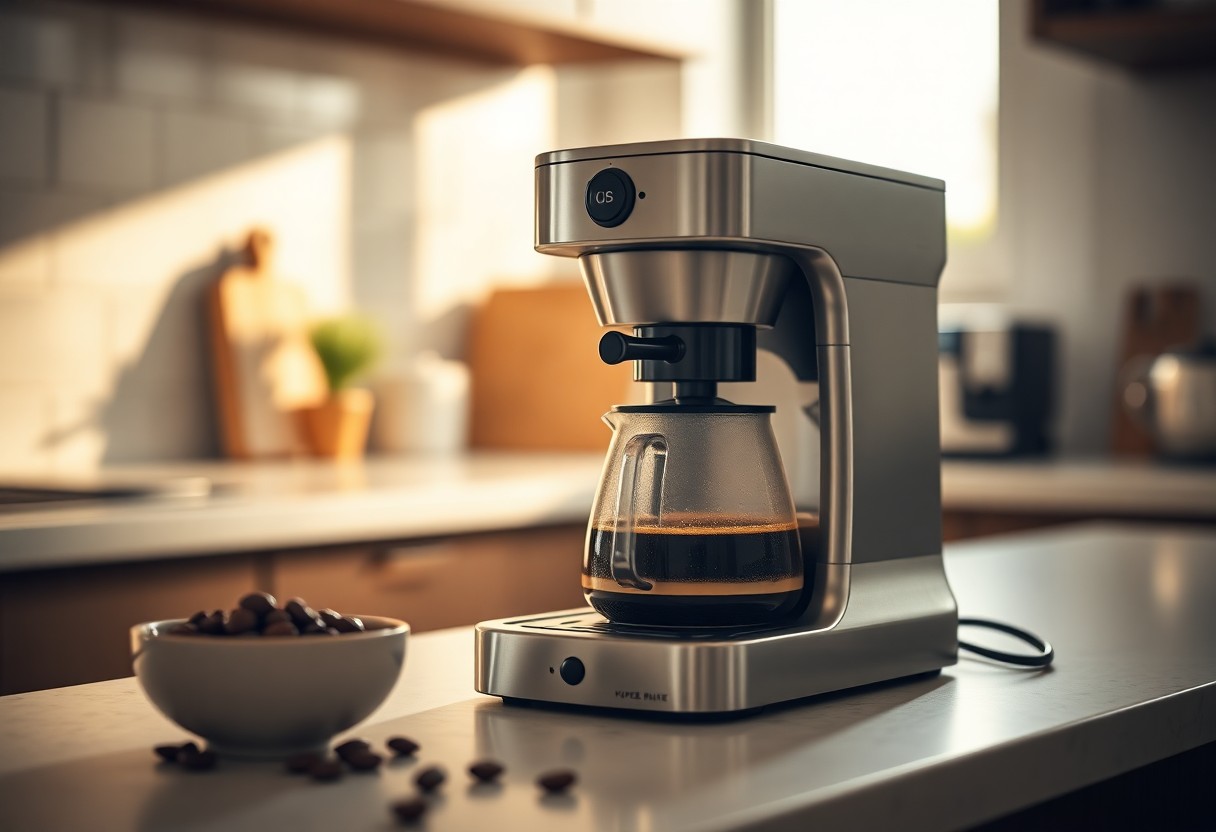
Key Takeaways:
- A filter coffee machine, also known as a drip brewing system, is designed to brew coffee by dripping hot water over ground coffee contained in a filter.
- The brewing process involves three main components: a water reservoir, a drip basket for coffee grounds, and a carafe to collect the brewed coffee.
- Drip brewing allows for consistent flavor extraction, making it a popular method for producing a large quantity of coffee at once.
- Most filter coffee machines come with programmable settings, allowing users to set brewing times and to customize their coffee strength.
- They typically require minimal maintenance, with the main tasks being cleaning the coffee basket and descaling the machine periodically to ensure optimal performance.
Brewing Mechanics: The Art of Drip Coffee
Your journey into drip coffee brewing involves a harmony of precision and technique. The drip coffee process employs gravity to extract the flavors from coffee grounds, with water coursing through a filter containing the grounds, resulting in a coffee brew that’s rich in essence and aroma. It’s interesting to note that what is the difference between metal or paper filtered drip methods and why choosing the right filter can impact your cup. Each brewing element contributes to the final taste, making your understanding of the mechanics pivotal.
The Role of Water Temperature and Time
Water temperature and brew time play a significant role in developing the ideal extraction of flavors. Using water that’s too hot can lead to bitter notes, while too cool may under-extract your coffee, resulting in a weak brew. Optimal brewing typically occurs between 195°F to 205°F (90°C to 96°C) with a brewing time of about 4 to 6 minutes.
| Water Temperature | Optimal range: 195°F to 205°F (90°C to 96°C) |
| Brewing Time | Suggested duration: 4 to 6 minutes |
The Science of Coffee Grounds and Extraction
The extraction of flavor compounds from coffee grounds is a fascinating process that relies on several factors such as grind size, brew time, and the water-to-coffee ratio. Finding the right grind size is crucial; too fine and your coffee can become over-extracted, leading to bitterness, while too coarse may yield a weak and underdeveloped brew. The correct balance of these elements is key in achieving a flavorful cup of coffee that embodies your preferences.
Utilizing consistent grind sizes ensures an even extraction as water flows through the coffee grounds. A medium grind is generally recommended for drip coffee to promote optimal flavor extraction while preventing over-extraction. Aim for a coffee-to-water ratio of about 1:15 to strike the perfect balance between acidity, body, and sweetness, leading to a harmonious cup that tantalizes your taste buds.
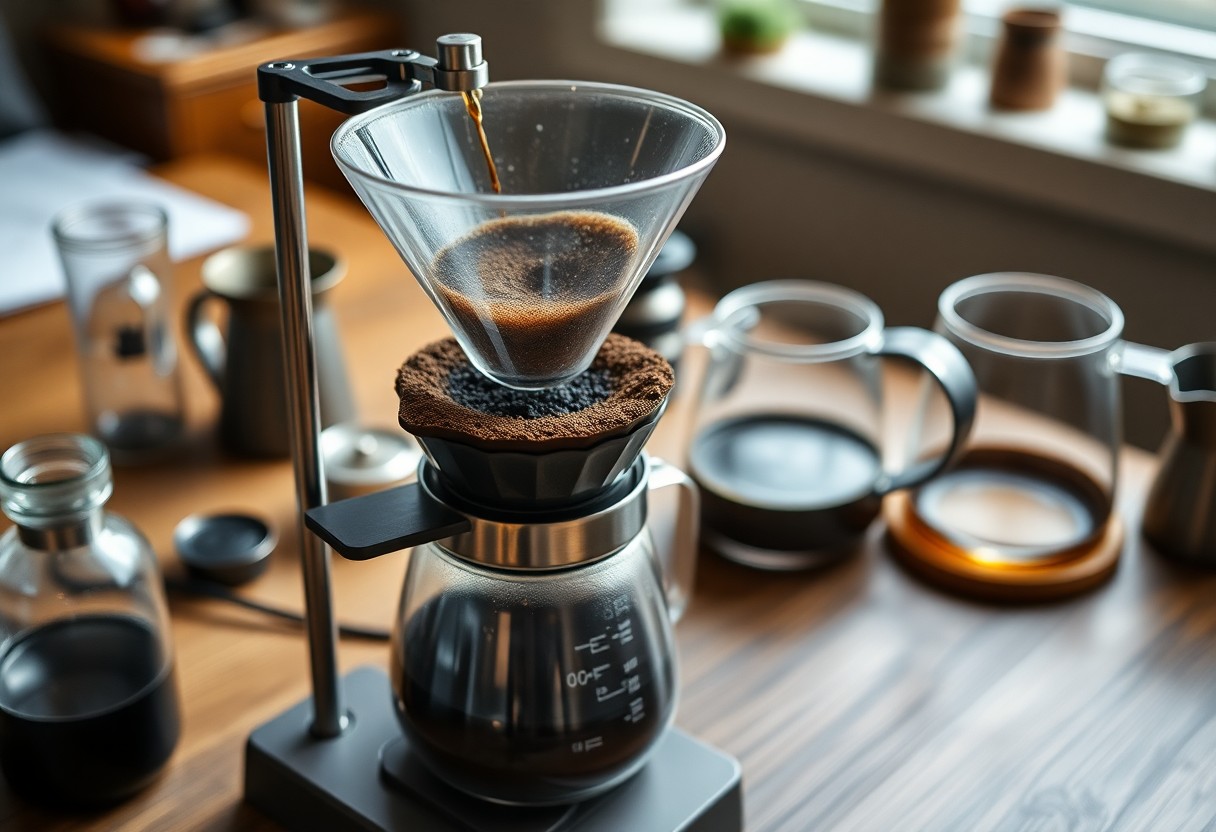
Essential Components of a Drip Brewing System
The core elements of a drip brewing system work together to create the perfect cup of coffee. Each component plays a vital role in ensuring that the water temperature, flow rate, and brewing time are optimized for extracting rich flavors from your coffee grounds. It’s necessary to know how these parts interact to achieve that smooth, aromatic brew you desire.
Key Features of a Filter Coffee Machine
Understanding the key features of a filter coffee machine can elevate your brewing experience. These features not only enhance functionality but also contribute to the overall taste of your coffee.
- Water Reservoir: Holds the water used for brewing.
- Filter Basket: Contains the ground coffee and allows brewed coffee to flow through.
- Carafe: Collects the brewed coffee and offers a serving vessel.
- Heating Element: Heats the water to the ideal brewing temperature.
- Drip Tray: Catches spills and keeps the area tidy.
- Programmable Options: Lets you set brew time and strength preferences.
After knowing these key features, you can identify which aspects are most critical for your personal brewing style.
Variations in Design: From Simple to Advanced
Filter coffee machines range significantly in design, which can greatly influence functionality and user experience. Simplicity in design often accompanies user-friendly features, while advanced models may offer additional features like programmable settings and integrated grinders.
- Basic Drip Coffee Maker: Simple, no-frills design aimed at easy brewing.
- Programmable Models: Allow customization of brew times and strengths.
- Built-in Grinder: Freshly grinds coffee beans before brewing.
- Single-Serve Machines: Brew one cup at a time, often with pods.
- High-End Models: Offer features like temperature control and specialty brew options.
| Type | Features |
|---|---|
| Basic Drip | Standard brewing functionality. |
| Programmable | Set brew times, adjust strength. |
| With Grinder | Grinds beans for fresher coffee. |
| Single-Serve | Convenient, no waste brewing. |
| High-End | Advanced brewing controls and features. |
Exploring the variations in design can lead to discovering the machine that perfectly suits your coffee-making habits. From a basic model to a high-end machine, the features can significantly impact your brewing experience and flavor profile.
- Choose a model that fits your lifestyle – whether that’s convenience or a love for artisanal coffee.
- Consider the capacity based on how many cups you typically brew.
- Evaluate your willingness to experiment with more advanced features.
- Read reviews and compare models to ensure quality and performance.
| Aspect | Consideration |
|---|---|
| Capacity | Amount of coffee typically brewed. |
| Features | Programmable settings and convenience options. |
| Price | Budget based on desired features. |
| User Reviews | Feedback from other coffee enthusiasts. |
The Flavor Equation: Impact of Brewing Variables
Your coffee’s flavor is influenced by several brewing variables, and understanding their synergy is key to achieving your desired taste profile. From the What is Drip Coffee Maker: In-Depth Guide to a Perfect Brew, you’ll find that a combination of grind size, water quality, and brew time can transform your morning cup from mediocre to magnificent. Adjust these variables thoughtfully to explore the rich spectrum of flavors waiting to be discovered in each brew.
Grind Size and Its Influence on Taste
The grind size of your coffee beans has a direct impact on extraction, influencing how well flavors are drawn out during brewing. A finer grind can yield a stronger extraction, but go too fine, and you risk bitterness; too coarse, and you may end up with a weak cup. Finding the right balance is necessary for harnessing the full potential of your beans.
Water Quality and Its Taste Profile
Water quality plays a significant role in coffee flavor, as it constitutes about 98% of your brew. Chlorine and other impurities can spoil the natural flavors of your beans. Ideally, you should use filtered or bottled water, which permits the coffee’s subtler notes to emerge, giving your cup a cleaner, more vibrant taste.
Hard water, which contains higher mineral content, can also alter your coffee’s flavor. The presence of calcium and magnesium may enhance extraction for a fuller body but might lead to off-flavors if the balance is not right. Conversely, soft water may lack sufficient minerals, resulting in a flat taste and poor extraction. Aim for a balanced water composition (around 150 mg/L total dissolved solids) to ensure your coffee showcases its true character.
The Environmental Considerations of Drip Coffee
Drip coffee machines, while popular, raise some environmental concerns worth evaluating. From waste production to the energy consumed during the brewing process, your choice of coffee can impact the planet. By understanding the environmental footprint of your coffee-making habits, you can make informed decisions that align better with sustainable practices. Identifying sustainable options can help minimize waste and energy usage, making your coffee ritual environmentally friendlier.
Waste Management of Coffee Filters
Coffee filters, often overlooked, contribute significantly to landfill waste. Traditional paper filters are typically single-use and non-recyclable, leading to thousands of filters being disposed of daily. Opting for reusable metal or cloth filters can effectively reduce this waste. Consider purchasing biodegradable filters made from natural materials to lessen your ecological impact, ensuring your coffee routine is more sustainable and responsible.
Energy Consumption and Sustainability
The energy consumed by drip coffee machines varies, but many modern models are designed to be more energy-efficient. Despite these improvements, every cup of coffee contributes to your overall energy usage throughout the day. To enhance sustainability, you can select machines that feature energy-saving modes, or even better, transition to manual brewing methods. This reduction in energy demand can have a meaningful impact on your carbon footprint.
For instance, a typical drip coffee maker may use about 800 watts of power during brewing. Over time, this adds up, especially if used daily. Switching to a high-efficiency model can cut energy consumption by 30% or more. Additionally, consider investing in a thermal carafe to keep your coffee warm without a hot plate, further decreasing energy waste. Every small adjustment you make in your coffee preparation can lead to a more sustainable ritual, joining the collective effort towards a greener future.
Practical Tips for Perfecting Your Brew
For a consistently great cup of coffee with your filter coffee machine, follow these practical tips:
- Use fresh, high-quality coffee beans.
- Maintain the ideal water temperature between 195°F and 205°F.
- Experiment with different grind sizes to find your sweet spot.
- Observe your brewing time; typically, 4-5 minutes works best.
- Clean your machine regularly for optimal flavor extraction.
This combination will elevate your coffee experience.
Maintenance and Care of Your Coffee Machine
Proper maintenance of your coffee machine is important for longevity and flavor quality. Regularly clean removable parts, such as the carafe and filters, using warm, soapy water. Run a solution of equal parts water and vinegar through the machine every month to remove mineral buildup. Always consult your manufacturer’s guidelines for specific maintenance tips tailored to your model. A well-maintained machine will help you achieve that perfect brew.
Experimenting with Ratios for Personal Taste
Finding your ideal coffee-to-water ratio is key to enhancing your overall experience. You can begin by using the standard ratio of 1:16, meaning one gram of coffee for every 16 grams of water. However, don’t hesitate to adjust this based on your taste preferences. For a stronger cup, increase the coffee amount, or decrease it for a milder flavor. Engaging in this exploration allows you to discover the precise balance that suits your palate best.
As you experiment, try measuring in grams rather than tablespoons for greater accuracy. Start with a range like 55-65 grams of coffee per liter of water, and adjust from there. Keeping a journal could help track your adjustments, making it simpler to pinpoint your favorite blend. This kind of hands-on approach not only fine-tunes your brewing skills but also transforms coffee-making into a personalized craft that reflects your unique taste preferences.
To wrap up
On the whole, a filter coffee machine utilizing a drip brewing system offers an efficient and straightforward way to brew coffee at home or in an office setting. By harnessing the power of hot water flowing through coffee grounds, you can enjoy a rich and flavorful cup of coffee tailored to your preferences. Understanding how these machines operate not only enhances your brewing experience but also allows you to make informed choices when selecting the right device for your needs. With the right machine, you can elevate your coffee routine and savor every sip.
FAQ
Q: What is a filter coffee machine using the drip brewing system?
A: A filter coffee machine, commonly known as a drip coffee maker, is a kitchen appliance designed to brew coffee by dripping hot water over ground coffee contained in a filter. The machine typically has a water reservoir, a heating element, a drip basket for the coffee filter, and a carafe to collect the brewed coffee.
Q: How does the drip brewing process work?
A: The drip brewing process involves several steps. First, water is poured into the machine’s reservoir. The machine heats the water to the optimal brewing temperature. Once heated, the water is directed through a spray head that disperses it evenly over the coffee grounds in the filter. As the water extracts flavors from the coffee, it drips down into the carafe below, producing a fresh brew which can be served immediately.
Q: What type of coffee should I use in a filter coffee machine?
A: It is best to use medium roast coffee grounds that are specifically brewed for drip coffee makers. You can choose to buy pre-ground coffee or grind your own beans to achieve your preferred coarseness. A medium grind is generally recommended, as it allows for optimal extraction while preventing over-extraction that can lead to bitterness.
Q: How do I clean and maintain my filter coffee machine?
A: Regular cleaning of your filter coffee machine is important for maintaining taste and performance. Empty and rinse the carafe after every use. Additionally, perform a deep clean by filling the water reservoir with equal parts of vinegar and water and running a brew cycle without coffee. After this, run several cycles with clean water to remove any residual vinegar. Regularly inspect and replace the coffee filter as needed, whether it is a reusable metal filter or disposable paper filter.
Q: Can I make other beverages aside from coffee with a filter coffee machine?
A: While the primary function of a filter coffee machine is to brew coffee, you can adapt it to prepare other beverages. Some users experiment by brewing herbal teas or infusing hot chocolate by placing the ingredients in the coffee filter. However, keep in mind that these alternative uses can impact the machine and the flavor profile of future coffee brews, so it’s wise to use caution and follow proper cleaning protocols.

